Thanks for the vote of confidence there Mr Walker you are quite right, failure in ones endeavours is never acceptable not for a golfer and not for a foundry man. I'd best get on with it then...

You are using an out of date browser. It may not display this or other websites correctly.
You should upgrade or use an alternative browser.
You should upgrade or use an alternative browser.
Sand casting unobtainium parts at home.
- Thread starter 56 Fregate
- Start date
I did a pour today. Velocity stacks for weber 36DCD. First time in allmost two years so I was rusty and the sand dry.


Hey good effort Reidar. I like your pouring basin design which looks text book. Yes the sand does look dry, was it a commercial sand or did you mix your own.
I've thrown all my green sand away and need to start again with fine sand and bentonite but I reckon I'll have a go with sand/bentonite/vegetable oil so I can eliminate moisture from the process.
Good work, keep it coming.
I've thrown all my green sand away and need to start again with fine sand and bentonite but I reckon I'll have a go with sand/bentonite/vegetable oil so I can eliminate moisture from the process.
Good work, keep it coming.
I bought a 25kilo bag of comercial greensand from the local foundry. I have had tree sessions/attempts to cast inlet manifolds allmost two years ago. I had it sorted in tree different buckets with airtight lids. One is totally dried out, one is kind of rammable and until yesterday I had a small amount that was not used before. I used that for the cores and as facing sand.Hey good effort Reidar. I like your pouring basin design which looks text book. Yes the sand does look dry, was it a commercial sand or did you mix your own.
I've thrown all my green sand away and need to start again with fine sand and bentonite but I reckon I'll have a go with sand/bentonite/vegetable oil so I can eliminate moisture from the process.
Good work, keep it coming.
As I understand hydrating it is not too complicated so I will give that a try.
I guess the sprue and pouring basin is what I’m most pleased with. I have studied Martin/Olfoundryman’s videos. The rest of the gating between sprue, riser and mould were cut with a teaspoon and is a bit rough.
It was a controlled and slow pour where the spue filled suddenly and remained filled.
The riser was cut with a thin walled pipe. Not sure I will do that again as it made the surrounding sand crumble. Actually it made all the sand fall out of the flask on the first attempt. On the second attempt a lot of sand also fell out(some of it is visible in the cast) but I desided to go give it a go. I blew out loose sand before closing the mould but some more seems to have losened either when I put in the cores or closed the mould.
I used a small glass fusing kiln. It is only 2000W and will not go mutch above 800C.
When I started this it seemed like the perfect melting metod accept real slow. But since then the price of electricy have gone throug the roof. Norway have been blessed with cheap electricy. We have exported to the rest of Europe for years with no problems at all but now politics have caused us to import the electricity prices from the energy starved EU.
Anyway our price of electricity is nearly 20times higher then two years ago.
Anyway our price of electricity is nearly 20times higher then two years ago.
I just realized I was complaining while I had no idea what was the situation in Australia. From what I can see the electricity costed about the same in Australia as in Norway in June. We have been spoiled for years I guess…
I’ve tried to rehydrate the sand today. I spread it on a tarpaulin and added about 3dl of water with a spray can. Did not seem like mutch but I was afraid to wet it. Raked it backed and forth and rolled it into itself on the tarp. The i passed it through a siff into air tight buckets.
I’ll let it set for a few days and see.
Hmm here is an interesting set of comparison data on electricity pricing around the world. I note Australia is no16 from the top  .
.
https://www.electricrate.com/data-center/electricity-prices-by-country/
What that tells me is the transition from Government owned and run electricity systems years ago to a free market system of selling off the hardware and using multi private retail sales companies for "competition" has been an abject failure. Hmm turn back the clock IMHO.
I did not see where Norway is on the big list but having a rise of 20x is shocking and must be hard for some to be able to afford in your cold climate ! You might have to get the neighbours in to huddle around your furnace and contribute to the power bill !
You might have to get the neighbours in to huddle around your furnace and contribute to the power bill !
Jaahn
PS keep up the interesting casting story please. I recall working in the foundry as an apprentice occasionally. Bloody sand everywhere, as opposed to grease or just dirt in most of the rest of the place.
https://www.electricrate.com/data-center/electricity-prices-by-country/
What that tells me is the transition from Government owned and run electricity systems years ago to a free market system of selling off the hardware and using multi private retail sales companies for "competition" has been an abject failure. Hmm turn back the clock IMHO.
I did not see where Norway is on the big list but having a rise of 20x is shocking and must be hard for some to be able to afford in your cold climate !
Jaahn
PS keep up the interesting casting story please. I recall working in the foundry as an apprentice occasionally. Bloody sand everywhere, as opposed to grease or just dirt in most of the rest of the place.
Last edited:
About a year ago I needed some machinery hand wheels for my milling table, I made two but now wish I had made a couple of extras. I used an existing steel wheel borrowed from my thickness planer as a pattern but didn't take any photos of the process. I spun the cast aluminium blanks in my lathe to make them look pretty, a dash of paint, a dollop of aluminium polish and there it is. They'd be about 9 inch.

Hmm here is an interesting set of comparison data on electricity pricing around the world. I note Australia is no16 from the top.
https://www.electricrate.com/data-center/electricity-prices-by-country/
What that tells me is the transition from Government owned and run electricity systems years ago to a free market system of selling off the hardware and using multi private retail sales companies for "competition" has been an abject failure. Hmm turn back the clock IMHO.
I did not see where Norway is on the big list but having a rise of 20x is shocking and must be hard for some to be able to afford in your cold climate !You might have to get the neighbours in to huddle around your furnace and contribute to the power bill !
Jaahn
PS keep up the interesting casting story please. I recall working in the foundry as an apprentice occasionally. Bloody sand everywhere, as opposed to grease or just dirt in most of the rest of the place.
I am not sure how that comparison is levelled? Are prices just simple conversions from one currency to another? Or something else?
Also keep in mind that 1 dollar may be cheap in the US but is mighty expensive in say Bangladesh.
I would suggest a more informative comparison would be between how much it cost a person in real terms to use 1kW of power. (say how many loaves of bread locally bought or some such).
It is also very interesting to see why energy prices for oil independent countries have moved so much. I read in Sweden one of the problems was the relative drought they have has affected hydro power and the way they decide energy prices meant fossil fuels (as little as they use) became competitive.
Not sure about Norway, but I would also guess energy markets are connected and prices in one market can impact others especially when there are exchanges in place.
Not sure about Norway, but I would also guess energy markets are connected and prices in one market can impact others especially when there are exchanges in place.
Errr, Jaahn's link has a table on it comparing the cost of electricity relative to income.I would suggest a more informative comparison would be between how much it cost a person in real terms to use 1kW of power. (say how many loaves of bread locally bought or some such).
Despite the heading in the article («updated Sept 2022») in Jaahn’s link the numbers is totally out dated. It actually does not say when they are from but I’m guess Jan 2022 based on the stated price for Germany(39US cents. In August it passed 50.
That is also why Norway is not on the list as in January most parts of Norway had a prize of 16cents. Today those have risen to 40-50.
What is quite funny is that sone 4 and 5(there is 5 price sones in Norway) electricity is still dirt cheap at 2-3cents/kwh. The power plants reservoirs are over flowing by water
This cover the north 2/3 part witch is the coldes and relatively few live. Good on them.
Its funny how big cables have been built from Norway to England and Denmark to ensure we have enough electricity while we have not connected the different parts of our own country.
Today we are not paying for the cost of production of electricity but what it costs to prevent it from being sent to Germany.
That is also why Norway is not on the list as in January most parts of Norway had a prize of 16cents. Today those have risen to 40-50.
What is quite funny is that sone 4 and 5(there is 5 price sones in Norway) electricity is still dirt cheap at 2-3cents/kwh. The power plants reservoirs are over flowing by water
This cover the north 2/3 part witch is the coldes and relatively few live. Good on them.
Its funny how big cables have been built from Norway to England and Denmark to ensure we have enough electricity while we have not connected the different parts of our own country.
Today we are not paying for the cost of production of electricity but what it costs to prevent it from being sent to Germany.
Another day-another pattern, made from whatever was at hand and nary a 3D printer in sight, it took probably an hour all up to fabricate.
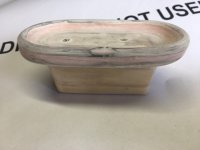

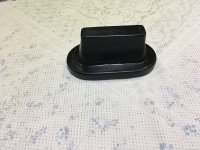
The sand mold was made from resin-bonded fine paving sand sifted with a fine mesh. Done in 3 stages which took yet another hour in total.
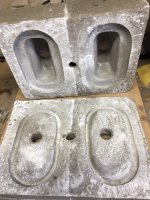
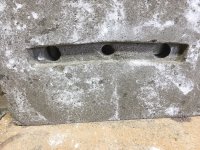
The pouring of molten aluminium also took an hour or so which was mostly set-up time. I had some shrinkage in the lower quarter but since these parts are mainly ornamental I'll correct it through the machining and linishing cycle. Now it's off to the machine shop for the treatment.
There's a Koala stamp on offer to whoever is first to guess what they are: Clue, they're French.
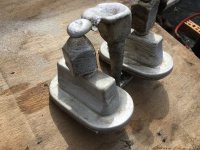
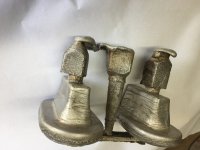
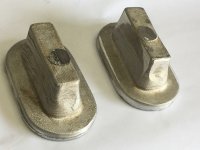
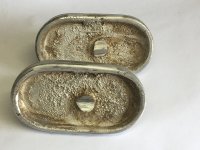



The sand mold was made from resin-bonded fine paving sand sifted with a fine mesh. Done in 3 stages which took yet another hour in total.


The pouring of molten aluminium also took an hour or so which was mostly set-up time. I had some shrinkage in the lower quarter but since these parts are mainly ornamental I'll correct it through the machining and linishing cycle. Now it's off to the machine shop for the treatment.
There's a Koala stamp on offer to whoever is first to guess what they are: Clue, they're French.




Maybe door handle surrounds?…jim
Pedals?
No, no, nonono. None of those are even close but I hope I get time to finish them tomorrow. Having the facility to build your own parts is just heaven and opens up a whole new world for the home-hack tinker.
Replacement heels for Mrs 56 Fregate's favourite pair of Christian Louboutin shoes?
What kind of sand are you using? Sodium silicate bound or something more exotic?Vintage piston making for the home hack.
Of course it is well within the realm of possibility that a home-hack sand caster can find ways to make pistons, I know this because I worked it out a while back. This was all about the exercise rather than the end result and no particular alloy was used, just some leftovers from the bin. If I were to ever have the need to get serious about making a piston I would make some changes to the process, but it is eminently doable at home.
Follow the steps kids, it's easy.
View attachment 208158View attachment 208159
View attachment 208169
View attachment 208160View attachment 208161View attachment 208165View attachment 208166View attachment 208167
I rehydrated what is left of my bought green sand the other day. 20kg or so. Some of it was dry like dust but I only added 2-3dl of water with a spray can. I spread it on a tarp with a rake, sprayed and worked it back and forth. After I siffed it into two air tight buckets.
I think it has about the right content of water but it does not feel like it did when new. Maybe there is other ingredients that burns up with use?
Hi Reidar, I have experimented with all sorts of sand but these days I prefer to use bricklayers sand from a landscape supplier. I usually need to dry the sand and sift it to my requirements.
With my pistons I tried both resin bonded sand as well as sodium silicate + Co2. Resin bonded sand takes longer due to curing times but that's what I use the most. Since switching to resin bonded my failure rate has dropped to almost zero and the big payoff, I have all but eliminated gas bubbles in my castings because I use completely dried sand and therefore no steam is generated while casting. Resin bonded sand might not suit the commercial foundry but for a home-hack making one-offs it works well.
Using resin bonded sand produces a rather acrid smoke when the hot metal is poured in and leaves fume marks on the finished casting but that is the price I pay for good castings. Sodium silicate doesn't do this.
With my pistons I tried both resin bonded sand as well as sodium silicate + Co2. Resin bonded sand takes longer due to curing times but that's what I use the most. Since switching to resin bonded my failure rate has dropped to almost zero and the big payoff, I have all but eliminated gas bubbles in my castings because I use completely dried sand and therefore no steam is generated while casting. Resin bonded sand might not suit the commercial foundry but for a home-hack making one-offs it works well.
Using resin bonded sand produces a rather acrid smoke when the hot metal is poured in and leaves fume marks on the finished casting but that is the price I pay for good castings. Sodium silicate doesn't do this.